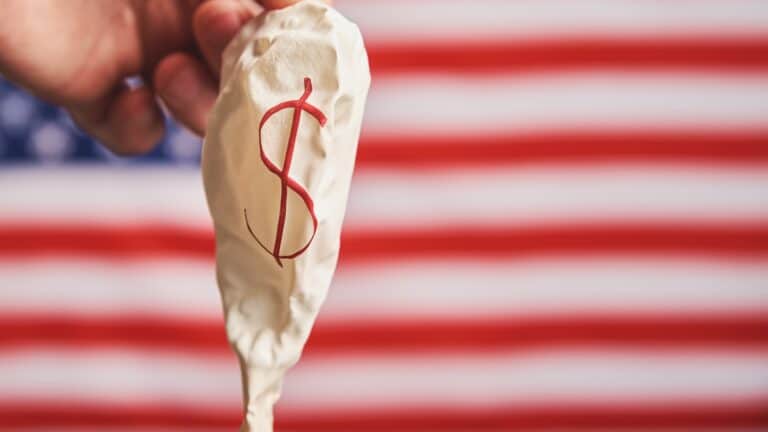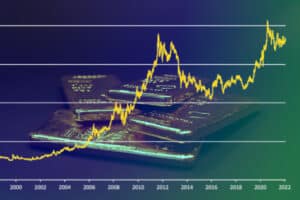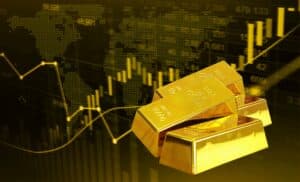Hyperinflation can throw economies into chaos – a nightmare no investor wants to experience. When prices for goods and services rise rapidly and uncontrollably, the value of the national currency plummets, causing the cost of living to skyrocket and people’s wealth to become worthless.
Hyperinflation can lead to economic collapse, political instability, and social unrest, posing a major threat to a country. However, by learning from past experiences and taking appropriate measures, governments can work towards preventing hyperinflation and protecting their citizens from its devastating effects.
Understanding Hyperinflation
Hyperinflation is characterized by extremely high and often accelerated rates of inflation. It’s usually defined when the monthly inflation rate exceeds 50%. This condition undermines the real value of the national currency by exceeding normal economic growth and leading to significant instability and uncertainty.
It’s usually the result of a significant increase in the money supply that isn’t supported by economic growth or confidence in the currency’s stability. This is often the case when governments face a large debt burden and resort to printing money to pay their debts.
Each hyperinflation event uniquely illustrates how a sudden, rapid increase in the money supply in an economy without corresponding output growth can lead to inflation that eventually disrupts monetary policy and causes severe socioeconomic tensions.
Effects Of Hyperinflation
Hyperinflation, an economic condition characterized by rapidly accelerating inflation rates, can have far-reaching effects on a country’s economic and social fabric. The consequences are not just limited to skyrocketing prices and diminishing purchasing power of a currency but extend to the disruption of regular economic activities and potential social unrest.
Economic Consequences
Hyperinflation can lead to a sudden and substantial loss in the value of people’s savings. Money that individuals and families have painstakingly saved over many years or even a lifetime can quickly lose value. This rapid devaluation can leave individuals and families in a financially precarious position, facing a future marked by economic uncertainty.
For businesses, the environment created by hyperinflation is full of challenges and unpredictability. As the cost of raw materials and labor skyrockets unpredictably and frequently, planning for the future becomes a Herculean task. This makes it increasingly difficult for companies to maintain profitability, leading to layoffs, reduced investment, and, in extreme cases, business closures.
As people lose confidence in the currency, there may be a move away from the formal economy to alternative trade methods. This can lead to the proliferation of barter systems or black market economies, where goods and services are traded directly, bypassing the devalued currency. Such shifts may exacerbate economic instability and pose additional challenges for policymakers as they seek to stabilize the economy and restore public confidence in the currency.
Social Consequences
Hyperinflation can significantly widen the economic gap between the wealthy and the underprivileged. The wealthy often hold their assets in tangible assets such as real estate, gold, or stocks. These assets usually retain their value or even increase in value during hyperinflation, allowing the wealthy to preserve their wealth.
The less privileged, on the other hand, often rely on cash or fixed incomes such as wages, pensions, or social security contributions. These forms of wealth quickly lose purchasing power during hyperinflation, leading to a significant decline in living standards.
When hyperinflation escalates, the cost of basic necessities such as food, housing, and health care can become prohibitively high for the average person. This rapid increase in the cost of living can lead to widespread social unrest. Demonstrations, strikes, and, in extreme cases, violent conflict may occur as people express frustration and despair over deteriorating economic conditions.
As economic conditions deteriorate, public confidence in the government’s ability to manage the economy can rapidly erode. This dissatisfaction may manifest in growing opposition to the incumbent government, protests, strikes, or even votes of no confidence. In extreme cases, political unrest can lead to changes in government or even the overthrow of the existing political regime.
Societal Fears: “Shrinkflation, Greedflation, and Doubtflation”
With its rapid and unpredictable rise in prices, hyperinflation can create various concerns and fears among consumers and society about the availability and quality of goods. “Shrinkflation,” for example, occurs when companies, to protect consumers from rising prices, subtly reduce the size or quantity of their products while holding prices constant. This can leave consumers feeling shortchanged, as they receive less value for the same money.
“Greed inflation” is when companies capitalize on the chaos of rapidly rising prices and raise their prices disproportionately. Consumers, already struggling with the economic effects of hyperinflation, are hit even harder as they can no longer afford goods and services. This can lead to frustration and resentment among customers who feel they’re being taken advantage of in an already difficult economic climate.
Added to this is the fear of “doubt inflation,” a widespread feeling of uncertainty, and a lack of confidence in the stability and value of the national currency. As hyperinflation escalates, people begin to doubt the value of their money and its ability to act as a store of value. This can lead to panic buying and hoarding as people rush to exchange their rapidly depreciating money for tangible goods.
Historical Examples Of Hyperinflationary Periods
Historical hyperinflation periods provide valuable clues for understanding the devastating effects of hyperinflation on economies and societies. These periods serve as a stark reminder of the devastating impacts of hyperinflation and the importance of sound economic management.
Weimar Republic, Germany: 1921-1923
The hyperinflation experienced by Weimar Germany after World War I serves as one of the first and most prominent examples of the devastating effects of unchecked inflation. The German government, burdened with hefty war reparations imposed by the Treaty of Versailles, resorted to printing more money to meet these obligations.
The government’s tactic of printing more money to pay off its debts seemed like a feasible solution initially. However, as more money entered circulation, the value of the German Mark began to decline drastically.
In a very short time, prices began to rise rapidly as the currency lost its purchasing power, quickly escalating into hyperinflation. This period is often remembered by images of people carrying wheelbarrows full of money just to buy a loaf of bread.
Hungary: August 1945 to July 1946
From August 1945 to July 1946, the Hungarian pengő, the national currency, became practically worthless. Prices skyrocketed at an alarming rate, with the daily inflation rate reaching an astonishing 207%. This extreme hyperinflation was caused primarily by the war reparations imposed on Hungary after World War II and excessive money printing by the government.
The value of people’s savings evaporated overnight, driving many into poverty and causing widespread economic hardship. Businesses also collapsed as they couldn’t keep up with rising costs, resulting in high unemployment rates.
Zimbabwe: March 2007 to Mid-November 2008
From March 2007 to mid-November 2008, Zimbabwe experienced one of the worst hyperinflations in history. Inflation skyrocketed to unimaginable levels, with prices doubling every few hours.
At its peak, monthly inflation reached a staggering 89.7 sextillion percent. This hyperinflationary cycle was triggered primarily by rampant government spending, mismanagement of monetary policy, and currency devaluation.
As a result, the Zimbabwean dollar became almost worthless, and people were forced to use foreign currencies for everyday transactions. The devastating effects of hyperinflation manifested in widespread poverty, unemployment, and social unrest throughout the country.
Venezuela: 2010s-Present
In an effort to tackle budget deficits and finance public spending, Venezuela’s government turned to the printing press, flooding the economy with more money. However, this increase in supply wasn’t backed by a corresponding increase in goods and services, leading to a rapid devaluation of the Venezuelan bolivar and soaring inflation rates.
Policies such as price controls, currency controls, and nationalization of key industries disrupted the functioning of the market, leading to shortages of goods and services. This further exacerbated inflation and shook consumer and investor confidence in the economy.
However, perhaps the most striking lesson from the Venezuelan crisis is the danger of over-reliance on a single commodity for national revenue. Venezuela is one of the world’s largest oil producers, and its economy heavily depends on oil exports. The country’s revenue plummeted when oil prices collapsed in the mid-2010s, leading to an economic crisis.
This over-dependency on oil revenues exposed the Venezuelan economy to the volatility of global oil markets. When prices were high, the economy prospered, but when they fell, it suffered.
How To Prepare For Hyperinflation
Navigating through hyperinflationary periods is a challenge for investors. Hyperinflation erodes the value of money, disrupts markets, and creates economic uncertainty. However, with the right strategies, investors can prepare for and weather these storms. Here’s how:
Diversify Your Investments With Precious Metals
Precious metals such as gold and silver offer intrinsic value transcending currency-based economies. Their value is not tied to a specific government or country, making them a global asset. For this reason, they are often considered a form of “currency insurance.”
When hyperinflation occurs, and confidence in a country’s currency fades, investors often flock to gold as a safe haven. It is seen as a reliable store of value, especially in times when other assets and paper currencies can quickly lose value.
In addition to its role as a hedge against inflation and as a non-correlated asset, gold also shines in terms of its liquidity. Gold can be bought or sold anywhere in the world with relative ease. This liquidity, combined with its universal appeal, makes gold an attractive asset for investors looking to protect their portfolios in times of hyperinflation.
Invest In Inflation-Protected Securities
Inflation-protected securities, such as Treasury Inflation-Protected Securities (TIPS) in the United States, are a special type of investment designed to protect investors from the erosive effects of inflation. These unique financial instruments provide a hedge against inflation and ensure that the value of your investment does not decline even if prices rise.
The U.S. Treasury issues TIPS, and their principal — the initial investment amount — is adjusted semi-annually by the Consumer Price Index (CPI), a key measure of inflation. That is, when inflation increases, the net present value of TIPS also increases. Conversely, when deflation occurs, the net present value is adjusted downward.
The interest rate of TIPS is fixed, but because the principal is adjusted for inflation, the amount of interest paid can increase or decrease. For example, if inflation increases, the principal amount of TIPS increases, and so does the interest payment because it is calculated on the adjusted higher principal amount.
At maturity, investors receive the adjusted or original principal, whichever is higher. This ensures that investors do not lose their original investment, even in a deflationary environment. Investing in TIPS ensures a return that is always higher than the inflation rate to preserve your investment’s real value.
Look For Opportunities Abroad
When investing in foreign markets, a portion of the investment portfolio is invested in international stocks, bonds, or other assets. In times of high domestic inflation, foreign investments can offer better returns because they aren’t directly affected by inflation in your home country.
The main advantage of this strategy is the potential for higher returns. As your local currency loses value during hyperinflation, foreign investments may increase relative to your local currency, leading to potential gains. Additionally, international markets may offer opportunities not available domestically, such as exposure to faster-growing economies or certain industries.
However, investing in foreign markets also brings with it several risks. One such risk is currency risk, where changes in exchange rates can significantly impact the value of your foreign investments. If the foreign currency appreciates against your home currency, it can increase your return, but if it depreciates, it can negatively impact your return.
There’s the risk associated with different market and regulatory rules. Each market has its own regulations and characteristics, which can lead to unexpected challenges if you aren’t familiar with them. Some foreign markets may lack liquidity or transparency, making buying or selling investments difficult.
Hedge Against Inflation With Precious Metals
If you’re looking for a way to hedge against inflation and diversify your portfolio, you should consider investing in precious metals. We offer a wide variety of physical gold, silver, platinum, and palladium bars and coins that you can store at home or in an IRS-approved precious metals IRA.
Want to find out why our clients call us the top gold IRA company? Call us now at (877) 646-5347 to speak with a member of our team about opening an account with Noble Gold Investments, or click here to create your free account now.







